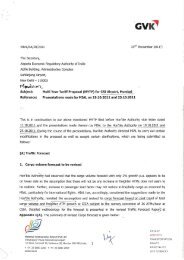Annexure II - AERA
Annexure II - AERA
Annexure II - AERA
You also want an ePaper? Increase the reach of your titles
YUMPU automatically turns print PDFs into web optimized ePapers that Google loves.
NERA<br />
Economic Consulti ng<br />
4. Conclusions<br />
The international evidence on land used for non aeron autical activities varies across<br />
jurisdictions as a single rule does not apply.<br />
The use of land for non-aeronautical activities comprises a variety of commercial<br />
activities like retail shops, car parking and real estate development. The real estate<br />
development is defined as the development and management of different kind of<br />
airport areas, for example hotels, conference centers and shopping malls.<br />
When a dual till regulation is applied, non-aeronautical activities are excluded from<br />
regulation, whereas when a single till regulation is applied, in many instances the<br />
regulation allows some non aeronautical activities to be excluded from the regulatory<br />
till. In cases where a hybrid till regulation applies, only some non-aeronautical<br />
activities are included in the regulatory till and only part of their profits is included in<br />
the till.<br />
Another issue we have examined is the treatment of surplus airport land, i.e. land in<br />
excess to what is needed for aeronautical use. This land, in some instances, can be<br />
sold and the airport operator can retain all revenues.<br />
In the case of HIAL we have pointed out that the airport has been privatized in 2004<br />
on the basis of a Concession Agreement.<br />
Our understanding, in the light of the explanations provided to us by GMR and after<br />
studying such agreements, is that HIAL has been privatized under a dual till<br />
regulation, where revenues of non aeronautical assets do not contribute to remunerate<br />
aeronautical costs.<br />
The international evidence examined shows that revenues from land used for non<br />
commercial activities have to be treated according to the regulatory regime which has<br />
been established at privatization.<br />
Furthermore, revenues of land disposal should be treated according to such regulation.<br />
Revenues from sale of non aeronautical assets should be for the benefit of the airport<br />
and should not be used to reduce aeronautical costs.<br />
As <strong>AERA</strong> has pointed out in Order No. 13/20 I0-11, the asset value monetization can<br />
be substantiated in a number of different ways (outright sale 'with or without<br />
restrictions on further transfer by the lessee, premium lease or lease rental, deposits or<br />
a combination of all these form, etc) ." As a consequence, the same principles which<br />
apply to land sales should apply to the other forms of alienating land.<br />
19 See article 7.5.1 of Order No. 13/20I0-11 issued by <strong>AERA</strong>. whi ch states . "Authority is also aware of the<br />
different forms of alienating ofland by the owner/lessor to actual users (generally lessee s). like outright sale<br />
'with or without restrictions on further transfer by the lessee, premium lease or lease rental. deposits or a<br />
combination ofal/ these forms. It Is also not feasible to contemplate, exhaustively, all such forms as may be<br />
devised for purpos es of operational flexibility by the Airport Operator. Such forms change the nature,and<br />
sometimes the quentum of the receipts from land exploitation, i.e whether they are to be regarded as capital<br />
12<br />
<strong>Annexure</strong> <strong>II</strong>-B<br />
CP No. 9/2013-14/T-12023(14)/1/2012- Tariff- Vol - <strong>II</strong>I <strong>Annexure</strong> <strong>II</strong>-B Page 50 of 51
















